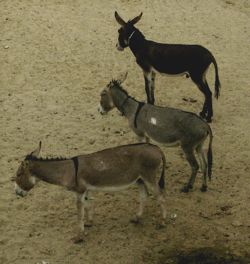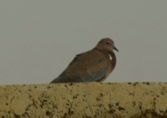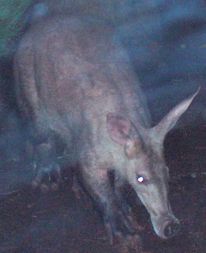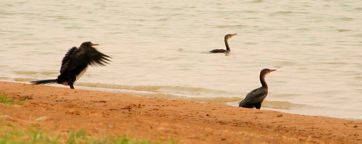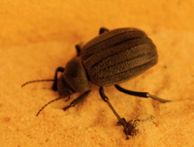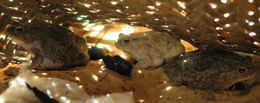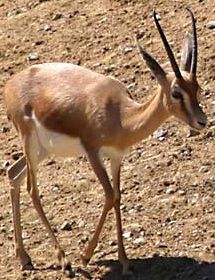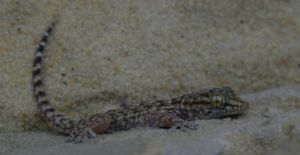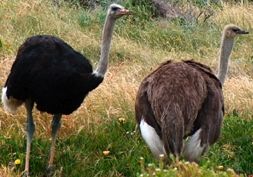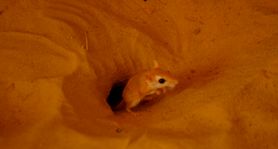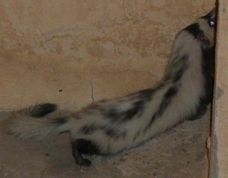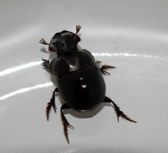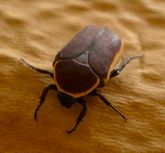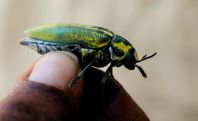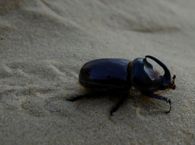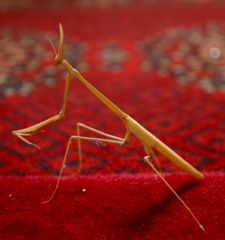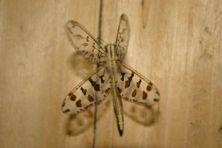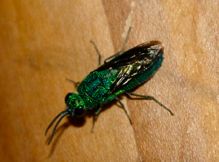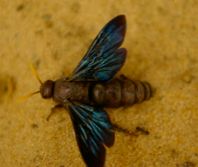Fauna of Timbuktu
Wildlife is limited in the desert and has grown more so in
recent years between droughts and hunting either for food
or sport or both. The following is what remains in the
zone:
Domestic
Animals
Camels
are
widely used by nomads as personal transport, transport of
goods and for food. For more information on the camel see
the page on camels.
Cats
are
common in the cities of the area. They are handy to control
the rodent population, and are kept as such with minimal
up-keep. However many people are superstitious of them,
associating them with witchcraft or sorcery. Witches are
believed to shape-shift and a cat is one of the animals
into which a witch may change. Also cats are believed to be
capable of stealing a person's soul. Many people are
careful to keep cats away from infants and are uneasy or
down right afraid to touch a cat or have one walk on them.
See also the page about eating cats. The cats
here tend to be thin with medium length hair and come in
whites, white with black spots, orange and mackerel
tabbies. There is apparently some wild variety of cat
that lives in the desert, though they can and do cross
with the town cats.
Chickens
are
smaller and tougher than we are used to seeing in the
western world their eggs are also considerably smaller and
due to species or diet often don't produce an egg everyday.
However they do provide a variation in protein for the
people in the area.
Cows
only barely
reach the zone of Timbuktu. They stick near the river
requiring far more water than sheep or goats. The cattle in
this area are a variety known as zebus they have a hump on
the back of the neck that may flop to one side. this hump
functions as a reservoir of fat similar to that of a camel.
It stores the necessary energy without overheating the cow
with a layer of fat on its entire body. They have large
curving horns and are predominately white, though dark
brown is not uncommon and the Fulani herder people have a
hundred odd ways of describing the nuances in the
coloration of a cow.
Dogs
seem to be
ubiquitous the world over but while they do exist in
Timbuktu they are actually relatively few in number. In
comparison to other cities in Mali or neighbouring
countries Timbuktu does not echo the night over with howls
and barking relays. This is apparently been the case for a
long time as René Caille comments on the lack of dogs
during his stay in Timbuktu 150 years ago.
Donkeys
are
indeed ubiquitous in and around Timbuktu. In this area they
are used in preference to the horse for pulling two wheeled
carts in addition to being general pack animals. In and
around town they pack burdens such as heavy goods home from
market or jugs of water home from the public faucet.
Caravans of donkeys can be seen going from Timbuktu to
Douenza and Dogon country where half-slabs of salt from the
taoudeni mines are traded for millet, onions and other
goods common in the south. The are usually greyish brown
with a black cross on the back (long line down the spine
and the cross bar over the shoulders) although white or
dark brownish black ones exist too. When not in use they
can be seen standing idly alone or in groups in pares the
like to stand facing each other with head rested on
opposing necks. Occasionally a donkey (or heard of donkeys)
will take it in head to go charging around braying wildly
with no apparent provocation. While donkeys do in fact make
a sound remarkably like "hee-haw" that simple word does not
do justice to that sound of a donkey's bray... especially
not in the middle of the night.

Goats
will eat
anything and it is probably a good thing here, as on the
Saharan boarder quality food can be scarce. In town these
animals graze the trash heaps for anything remotely edible
including scraps of cardboard and and plastic bags. Though
less prestigious than the ram they are eaten for meat and
the nanny goats produce milk that is made into cheese or
soured and used in a local beverage of refreshment called
zrig or for medicinal properties. The skin is preferred for
leather working as it is the most durable of the hides
available and is used to make geurba
(water bags) as
well as well buckets, shoes and drum heads to name but a
few items. Key characteristics that distinguish goats from
sheep is the short perky uplifted tail, and the shape of
the head. They have a more delecate shaped face with a
pointier muzzle.
Horses
Like camels the
horse has beein used for transport in the area for a very
long time. The local horses are of Arabian or some similar
stock. Small and hardy and adapted to the environment
Pigeons
Are
kept almost more than chickens, perhaps because they
require less care. They are eaten and make a tasty stew of
the local variety. However there seems to be far more of
them kept than accounts for how many are eaten. Young boys
seem to take a pleasure in raising them for no profitable
end use - as pets. When they do get tired of the
responsibility they may slaughter them and have a little
feast of grilled pigeon. Others escape to roost on roof
tops where only an agile user of the slingshot will
recapture them.
Sheep
are
an important animal in the zone and many families even in
the towns try to keep at least one or two in the yard. Ewe
milk is used as goat milk for beverage or cheese. Rams are
slaughtered and sold by weight by the town butchers (as are
goats, cows and camels) but are also purchased whole and
live in mass quantities for the religious celebrations
particularly Eid El Kabir, know as Tabaski. Sheep are also
a preferred sacrifice of family choosing to slaughter an
animal to distribute the meat in offering for a safe trip
or on a day when prayers are being offered for a sick
member of the family or to provide meat for a wedding or
baptismal celebration. In these later cases a wealthy
family may slaughter a cow or camel instead.
Sheep are often confused with goats by visitors used to the
bob-tailed wooly variety of Europe and North America. sheep
in Africa do not have their tails removed. They also have
much less wool for climatic reasons. however the wool they
do have is harvested, spun and woven. Blankets of this
material can be found in the markets. Hides with the wool
still on are cured and made into prayer rugs or mats for
the patriarch to sit on. Leg bones of the sheep and goats
are used to make tobacco pipes.
Wild/Native
Animals
Aardvarks
These peculiar
nocturnal creatures native to Africa are still to be found
in the Sahara north of Timbuktu. They have long snouts and
long claws on both front and hind feet to dig out the ants.
What I found particularly disturbing about the one I saw
was that the hind feet looked closely related to the human
hand I almost took it for a monkey’s paw. The back of the
hand was covered with short hair. The palm was leathery
with thumbs that are surely close to being opposable the
tipped by long nails that looked like overgrown
fingernails.
Bats
As
in most places bats come out at dawn and dusk to eat
insects and can be found nesting in abandoned buildings.
Occasionally one will fly into a open door or window not
find its way our immediately and spend the day hanging
upside down in a dim corner till the following evening
Birds
There are 606
species of birds both large and small in Mali. I have been
told by locals that seagulls have even been seen as far
inland as Timbuktu! While it is not a bird park one
bird-watcher said he saw eleven new birds on his trip to
Mali (that is ones he’d never seen before). Along the river
you can see many fishing and wading birds such as grebe,
pelican, cormorant, darter, herons bitterns, egrets,
hamerkops, storks, shoebills, Ibises, spoonbills, ducks,
geese, and osprey. Large birds of prey and scavengers such
as hawks, kites, eagles, buzzards, vultures, falcons and
owls are found in the edges of the desert and small grain
and insect eaters are all over the place. Examples include
pigeons, doves, finches, swifts, cuckoos, bee-eaters,
larks, swallows, martins, thrushes, warblers, and sparrows.
Larger terrestrial birds such as francolin, quail,
partridges, guinea fowl, bustard, ostrich are frequently
hunted for food by nomads. For the ardent birder you can
visit the page on birds for more
details.
“Bugs”
There is a very
rich insect life in the desert. Many are quite large. While
many might say “eew” to bugs they are generally benevolent
and rather fascinating only a few offer any danger and
those usually only when they feel threatened. The selection
of beetles is huge. The most common beetle to be seen is
the scarab. The scarab is sacred and a sign of good fortune
in Egypt. It looses a bit of its romance to learn that it
is in fact a variety of dung beetle. It is however more
elegant than the veritable dung beetle seen more commonly
in southern Mauritania its bulbous body crawling backwards
while it rolls a ball of manure with its rear legs puts one
in mind of the bumble bee: big and clumsy. See the sidebar
for a selection of insect life.
Elephants:
To the south east of Timbuktu in the circle of Bourem a
heard of elephants still circulates. These are protected
and are being tracked by radio tags. They run a loop
through the northern bit of Burkina Faso and up into Mali.
During certain seasons they can be found around the ponds
between Hombouri and Gourma Rharous.
Frogs
come out during
the rainy season. They hibernate under the mud in the areas
that flood seasonally. When the rains soften up the ground
they come out, mate, repruduce and leave a new generation
to carry on the tradition. During this time you can hear
the frog song at night and it is not uncommon to find the
occasional amphibian hopping around your yard in the night,
or hiding out in a cool dark corner during
the day.
Gazelles
Once very
common these graceful creatures are becoming harder to
find, though we still have people bring by baby ones that
they caught wanting to sell them to us. We refuse as they
are often too young to survive easily without their mother.
Gazelle horn is used by artisans particularly for
bracelets. The natural curve of the horns lends itself well
to such fabrication; the polished surface is then inlaid
with silver, bronze and copper designs.
Hippos
A
family of Hippos lives just down stream of Timbuktu in the
Niger river. It is a popular tourist activity to try and
spot them. These massive mammals spend most of their time
in the water and when the river is high you may only catch
a sight of their nose and ears when they come up to breath.
When the river is lower you can see more of them sticking
out of the water. Sometimes you can catch them on shore and
you can certainly see the great craters formed by their
footprints in the soft clay of the river banks. For all
their size they are fast swimmers and can be dangerous if
they feel threatened. I saw the desiccated head of a young
male who had been killed by local fishermen after it had
attacked someone.
Jackals
These nocturnal
members of the dog family are occasionally seen at a
distance. They are scavengers though they will also eat
small prey. They look rather like a fox in size an shape
with brown or yellowish fur and a darker stripe along the
back including the fluffy tail. The locals have some
superstitions concerning jackals for this reason jackal
skin guerbas
are
acquired for children for whom propitious portents have
been noted. It is supposed to bring good fortune, success
in all undertakings and assure one will always get the
better of ones enemies.
Lizards
A
profusion of species live in the zone. Geckos called
tilentari
by
the local population are dull earth colours. They have
rounded pads on their toes and their legs go out to the
sides bringing the body close to the ground. They look
rather like a rubber lizard in a toy shop. Geckos are
nocturnal and live off insects. They often hide out in dark
spaces in the house during the day; behind a folded back
window shutter or in the narrow gap between a wall and a
piece of furniture. They come out at night to eat insects
that swarm around the lights. If grabbed the gecko's tail
can come off to be re-grown later. The tail continues to
twitch after being detached, a mechanism to distract while
the gecko makes its escape. Locals are frightened of geckos
they claim they are poisonous and would do you harm should
they fall on you. They often try to kill them when they see
them. Geckos are harmless and, in fact, do good by eating
mosquitoes and other obnoxious bugs. It is also highly
improbably that they would fall on you considering that
they can walk across a plaster ceiling with no difficulty.
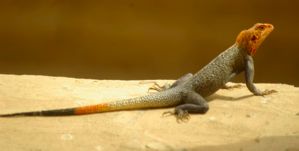
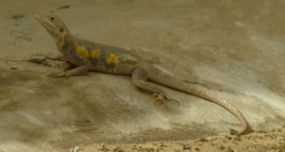
Another variety
of lizard called mbaga
is
day-living. The male is brightly coloured with an orange
head, blue body and reddish-orange tail. His female counter
part is smaller and greyish with orange and green mottling
on the sides. These lizards dart about stopping to do
push-ups and jerk their heads about. The have claws on
their toes instead of sticky pads. They always seem to be
holding themselves in fingertip-push up position and look
like they've been made of the hard moulded plastic of toy
dinosaurs in the toy shop.
Another variety also suspected of being poisonous and
mistrusted is a sand burrowing lizard. It has a roundish
body somewhat like a stubby snake with legs and is the
colour of sand. I have never actually seen one in nature
but the small boys sometimes catch them and keep then in a
can of sand to try and sell to tourists.
Chameleons are more rare and I have only seen one in the
zone. They prefer to live in trees. These creatures have
odd feet with two wide opposing sections that grip.
Ostriches
The
feathers of these large, flightless, long-necked,
long-legged birds were once a major commerce item on the
markets of Timbuktu. They are the largest bird in the world
and are very fast runners. They have been hunted to
scarcity in the region but their picture is used on the
packaging of one of the popular brands of green tea sold in
the area. They are the largest bird in the world and are
very fast runners.
Rabbits
live in the
bush and are hunted for food by the nomads.
Rodents
there are
several species of rodent in the area. A burrowing country
mouse, known as a jarboise, with cream underside and beige
back and a very long tail is rather pretty, and if captured
by the nomads can form a part of the diet. There is also a
variety of hopping mouse whose tracks can be seen on the
dunes in the morning.
Tortoise
These
long-lived herbivorous land turtles are prevalent
throughout west Africa's wherever the mandinge had
influence. They are the symbol of longevity and are good
luck to have in a household. In the Bambara tradition when
a new chief takes up the power a tortoise is brought and
remains in that household until the chief dies. The woman
who prepares the chief's meals sits upon the tortoise and
when it is ready gives it the first taste if it accepts
than the meal is good and the chief can eat it if the
tortoise refuses the meal is thought to be poisoned. It is
thought as long as the tortoise is present and well so will
remain the chiefdom. The Sognai of Timbuktu have adapted
the legend; the women sit on a tortoise when they
prepare toh,
a very thick sort of cream of millet, when finished they
will give the stiring paddle to the tortoise to taste the
paste stuck to it. If it eats the food is good if not...
well the head of household, at least, will not partake
thereof.
Zorrilla
This is
genetically a member of the weasel family but looks a lot
like a skunk, having the characteristic black body white
white stripes on the back and a fluffy tail almost as long
as the body, which is however long and narrow like the
weasel. Like the skunk it also has sent glands next to its
anus that spray a foul odour as a defence mechanism. They
are nocturnal and may come sniffing around human
habitations in search of food stuff. Fortunately the spray
is a last line of defence with running away or playing dead
like an opossum being preferred methods, because the
Guinness book of animal records states that one has held
off a pride of lions while feeding on their kill.


